Curious cat owners may ever wonder, “Can you put baking soda in cat litter?” Through this article, you’ll get tips for enhancing odor control efficiently with baking soda.
If you’re a cat owner, there’s a good chance you’ve faced the challenge of keeping your kitty’s litter box fresh.
Not only is it important for your home to smell pleasant, but managing odor is also vital for your cat’s health.
You’ve likely heard the tip of adding baking soda to the litter to mitigate unwanted smells.
It’s a natural deodorizer, and because it’s non-toxic, it’s safe for your cat, even if ingested in small quantities. (1)
But before you start sprinkling baking soda into your cat’s litter, there are some considerations to keep in mind to ensure the safety and comfort of your feline friend.
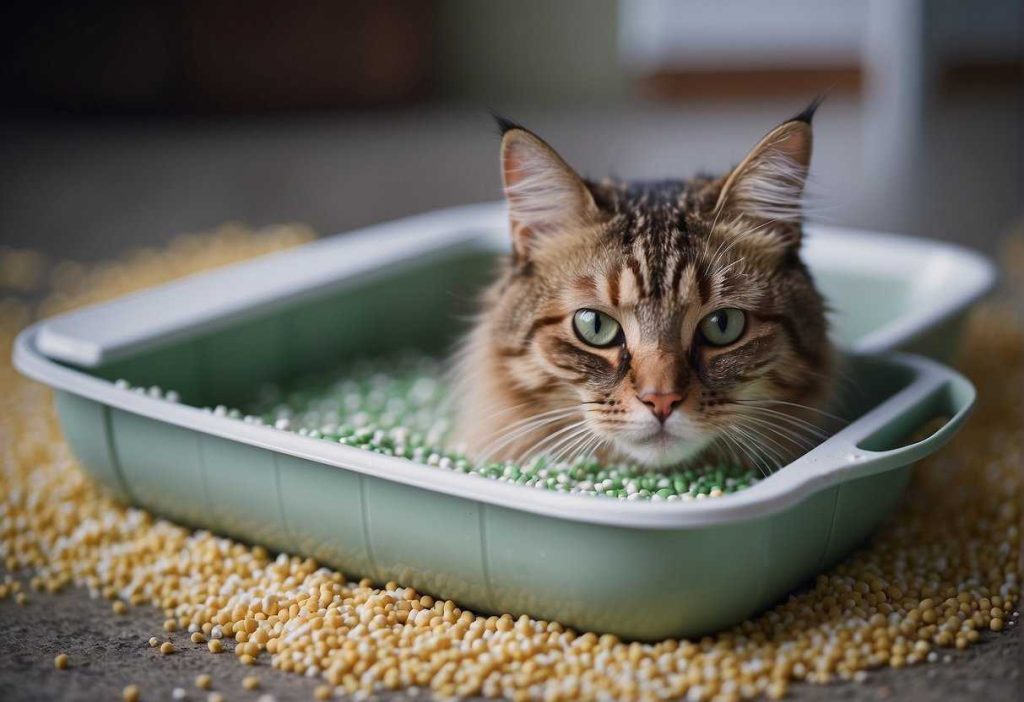
While baking soda can help absorb odors, using it correctly involves more than just pouring it into the litter box.
It’s crucial to understand the basics of how much to use and how often to apply it to avoid any potential health issues for your cat.
Additionally, alongside managing litter box smells, choosing the right cat litter and other products plays a significant role in overall odor control.
It’s beneficial to have expert insights and vet-approved guidelines at hand when deciding the best approach for maintaining your cat’s litter box hygiene.
Key Takeaways
- Baking soda is a safe, natural way to help control litter box odors.
- Proper usage is essential to ensure the health and comfort of your cat.
- Choosing the right products is key for effective and safe odor management.
Can You Put Baking Soda in Cat Litter? Understanding the Basics
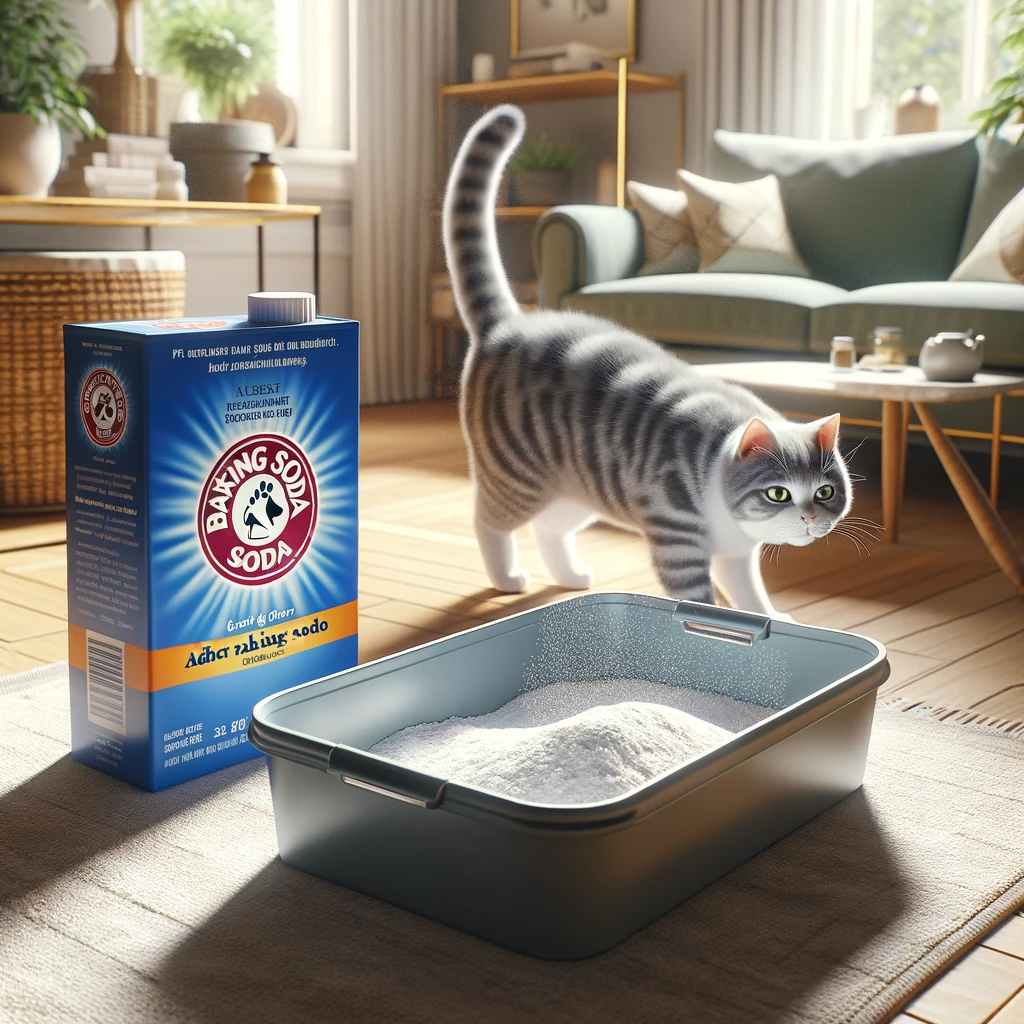
Baking soda, a common household item known for its odor-neutralizing powers, offers a simple solution. Here’s what you need to know:
The Role of Baking Soda in Odor Management: Baking soda, or sodium bicarbonate, has a reputation for absorbing odors. (2)
It’s like a little deodorizing superhero, swooping in to save the day (or at least your nose) from the assault of smelly cat litter.
Thanks to its alkaline pH level, baking soda neutralizes the more acidic scents of cat urine, which typically range from a pH of 6.3 to 6.6. (3)
How Baking Soda Works to Neutralize Odors:
- Absorption: Baking soda soaks up unpleasant odors.
- Neutralization: It reacts with acidic odors, balancing the pH and reducing the stink.
Benefits:
- Non-toxic: Safe for your furry friends.
- Deodorizing: Keeps the litter box, fresher.
- Easy to Use: Just sprinkle it on!
Limitations:
- Not a complete fix for all litter box odors.
- May require more frequent litter changes.
Here’s a quick guide on how to use it:
- Sprinkle a layer of baking soda on the bottom of the litter box.
- Fill with litter as usual.
- Consider a light sprinkle on top for extra freshness.
Remember, your cat’s comfort is paramount, so if they seem hesitant about their newly freshened bathroom, reassess the amount you’re using.
Just a pinch of that handy kitchen staple keeps life with your cat as sweet-smelling as can be. Who knew tackling cat odors could be almost as easy as pie—baking soda pie, that is?
Health and Safety Considerations for Using Baking Soda
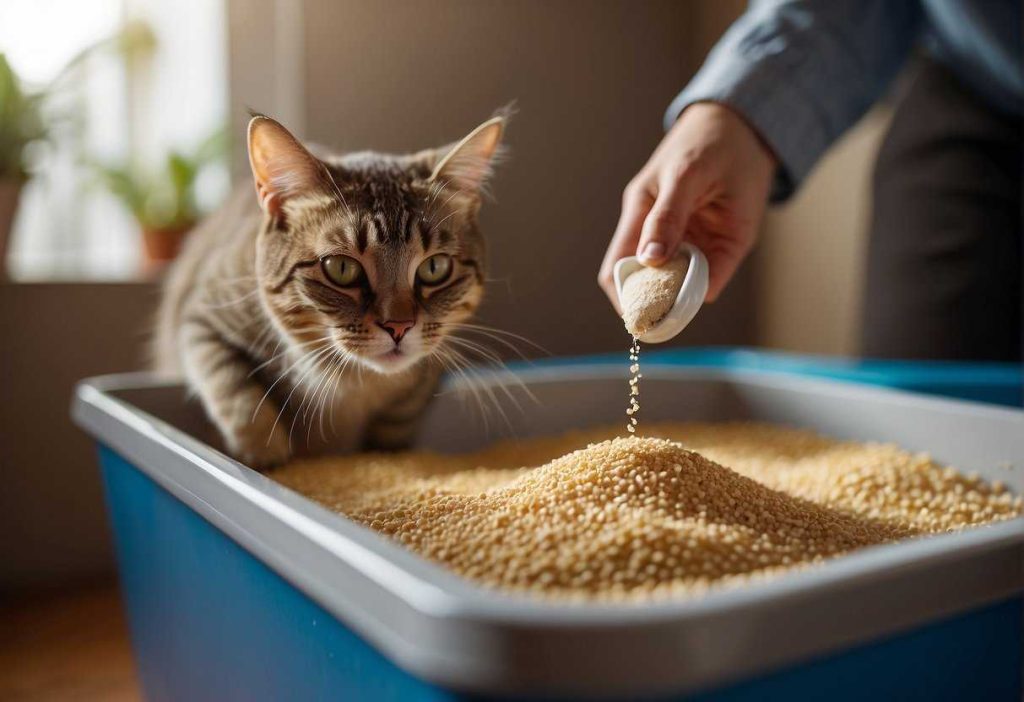
Baking soda is a safe additive for neutralizing odors without posing significant risks. (4)
Here’s how to keep things safe and comfy for your furry friend.
Potential Risks for Paws and Noses:
- Inhalation: Just a sprinkle will do. Too much baking soda might irritate your cat’s lungs.
- Ingestion: Cats clean themselves, so they might ingest a small amount. While small quantities are safe, larger amounts could cause digestive upset.
Understanding the Science:
- Baking soda, or sodium bicarbonate, works by neutralizing acidic odors, maintaining a balance that helps keep the litter box smelling fresh.
Vet-Approved Tips:
- Start Small: Begin with a modest amount of baking soda mixed into the litter.
- Monitor Your Cat: Some cats might be more sensitive. If you notice any changes in behavior, it’s best to remove it.
Baking soda can be a relatively effective way to manage odors and maintain a clean litter environment. Remember, it’s all about using it wisely and sparingly for the best results!
Practical and Safe Solutions for Odor Control
First, a clean litter box is a happy litter box. Here are some tips for maintaining order and freshness:
- Daily: Scoop out clumps and solid waste.
- Weekly: Replace litter and scrub the box with soap and water.
- Monthly: Consider a deep clean or replacing the box entirely.
Remember, your furry friend prefers a clean spot to do their business, just like you do. Keeping their environment pristine reduces stress and promotes better health.
Now, onto the main event— baking soda:
- Sprinkle a small amount on the bottom of the litter box before adding the litter.
- A light sprinkle on top can also neutralize odors, as it absorbs unpleasant smells and moisture.
But, what if you’re not a fan of baking soda, or are simply curious about alternatives? Worry not! Here’s a list of natural and innovative Odor-Fighting Allies:
- Activated Charcoal: Great at trapping odors without harsh chemicals. (5)
- Apple Cider Vinegar: A rinse of the box with this natural deodorizer could work wonders. (6)
- Commercial Odor Absorbers: Look for those that are non-toxic and designed specifically for pet areas.
Each home and cat is unique, so you might need to test a few methods to see which works best for you.
By keeping your cat’s litter box fresh, you’re not just banishing bad smells; you’re promoting a serene and happy kitty environment.
Give these solutions a try, and wave goodbye to nose-wrinkling greetings!
Selecting the Right Cat Litter and Other Products
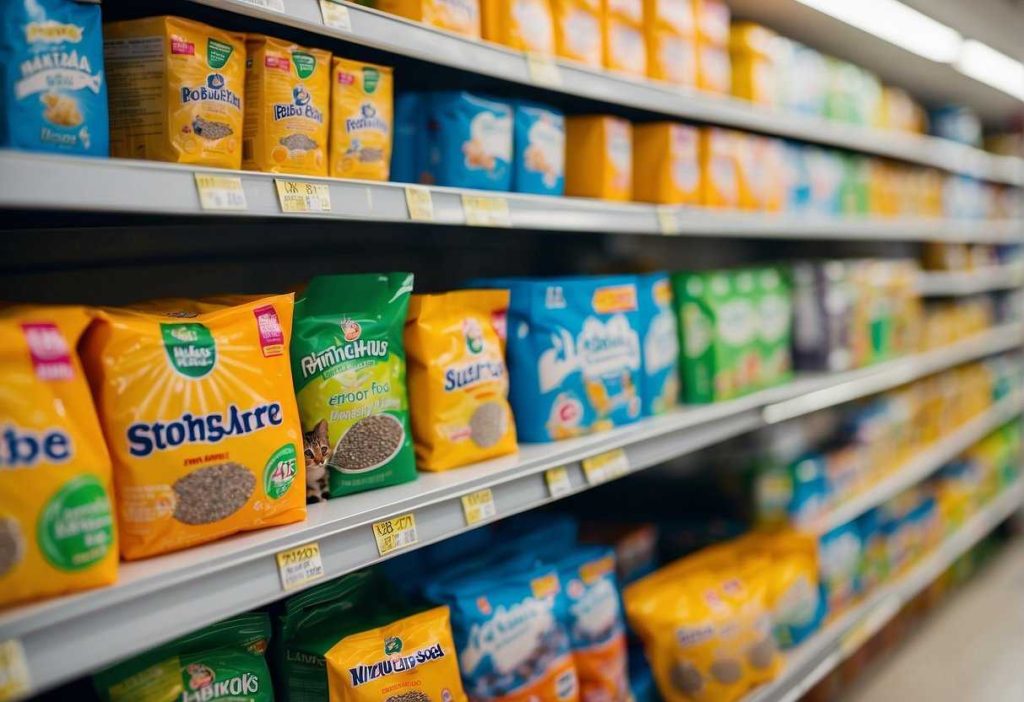
When it comes to keeping your furry friend’s toilet time tidy and odor-free, the choice of cat litter is crucial. Have you ever found yourself wondering if there’s a better option than what you’re currently using?
Let’s dig in!
Different Types of Cat Litter:
- Clay-based: Highly absorbent and budget-friendly.
- Silica gel crystals: Great for odor control, low dust, but pricier.
- Biodegradable options: Such as corn, wheat, and pine – they’re eco-friendly! (7)
Are you thinking about how to pick the perfect match for your kitty’s litter box? Consider these pointers:
- Odor control: Who wants a smelly home? Look for high odor-absorbing qualities.
- Dust levels: Got allergies or hate cleaning? Go low-dust.
- Environmental impact: Love the planet as much as your cat? Biodegradable may be the way to go.
When scooping the box, have you sniffed something less than pleasant? Baking soda might be your secret weapon. Safe and non-toxic, it neutralizes odors without any fuss.
Just sprinkle a small amount in the litter and voilà!
| Product Type | Pros | Cons |
|---|---|---|
| Clay-based | Affordable, Effective | Not eco-friendly |
| Silica Gel | Low dust, Excellent odor control | Higher cost |
| Biodegradable | Eco-friendly, Good odor control | Might need more frequent changing |
Got an eye on new products? There’s always something innovative popping up. Read reviews, and don’t be afraid to try out the latest buzz in the cat community for that purr-fect experience.
Remember, not every litter type suits every cat or home.
Perhaps, your long-haired beauty needs a litter less prone to sticking in their fur, or maybe your apartment is just too small for certain types.
It’s about finding your and your cat’s sweet spot. And hey, your furry friend’s paws have to approve too!
Keep an eye out for eco-friendly deodorizers to add a breath of fresh air to your litter-troubleshooting arsenal. Your nose (and your cat) will thank you!
Expert Insights and Vet-Approved Guidelines
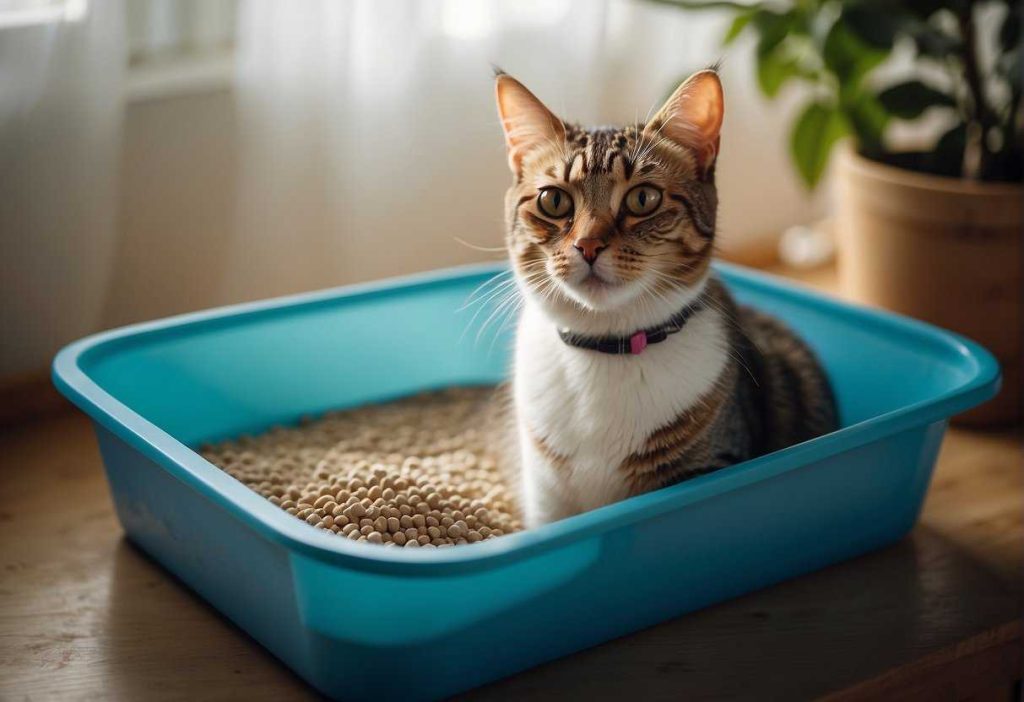
Let’s talk about baking soda—the secret weapon many of you have been using to tackle that notorious cat box odor.
How Safe Is Baking Soda for Cats?
First off, you might be asking, “Is baking soda really safe for my furry friend?” According to experts, the answer is a resounding yes!
Baking soda is non-toxic, and in small amounts, it can be a safe additive to your cat’s litter. Here’s a quick checklist to keep things safe and effective:
- Non-Clumping Litter: Sprinkle ¼ cup of baking soda directly onto the bottom of the litter box before adding the litter.
- Clumping Litter: Mix in the baking soda with the litter to help prevent it from clumping excessively.
Tips to Maximize Effectiveness:
- Moderation is Key: Too much baking soda can deter your cat from using the litter box.
- Regular Changes: Replace litter and baking soda regularly to maintain a clean, odor-free environment.
Did you know cat parents like you have shared their success stories? They’ve noticed a significant decrease in litter box odors by following these guidelines.
Baking soda helps neutralize those potent urine smells that can make your nose want to take a holiday!
Yet, what about real-life insights? Jane, a lifelong cat owner, swears by baking soda. She’s managed to keep her multi-cat home smelling fresh without any fuss from her feline family.
Remember, every cat is unique, so it’s always a good idea to keep an eye on your kitty’s behavior with any litter box changes.
If you notice any hesitance or changes in your cat’s bathroom habits, it might be time to reassess your strategy.
Looking to dive deeper into this topic? Consulting your local vet can give you peace of mind and ensure that you’re providing the best for your beloved pet.
Quick Recap

Baking soda in the litter box – you’ve probably heard about it, right? Let’s break it down in a quick, user-friendly way:
What is Baking Soda?
- Also known as sodium bicarbonate.
- pH level: A basic substance with a pH of 9.0.
Your Cat’s Urine:
- Normal pH is between 6.3 and 6.6, slightly acidic.
Why Add Baking Soda?
- Odor Absorption: It’s commonly used to neutralize odors at home.
- Safety: It’s generally safe for use in your cat’s litter tray.
How to Use:
- Sprinkle a small amount over the litter.
- Mix it in to help control odors.
Note:
- Use sparingly to avoid overdoing it.
Expert Opinions:
- Vet-approved for safety and effectiveness.
Remember:
- When it comes to litter boxes, freshness is key.
- Adding baking soda can be part of your freshness strategy.
Still curious? For a deep dive, check out vet-approved guides and in-depth expert articles. And don’t forget, a little research goes a long way!
Frequently Asked Questions
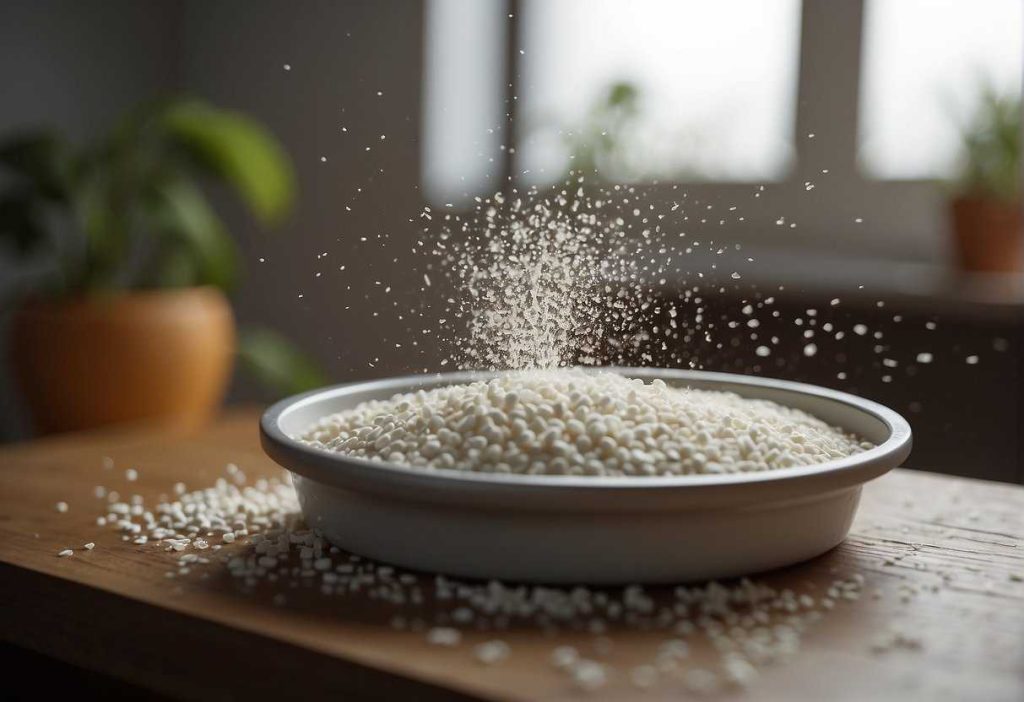
When it comes to keeping your cat’s litter box fresh, you might have heard about the wonders of baking soda. Let’s sift through some common queries to ensure your kitty’s comfort and hygiene.
Is baking soda safe to use in cat litter?
Absolutely! Baking soda is non-toxic and a safe additive for your cat’s litter box. It’s known for its deodorizing properties, making it great for absorbing unpleasant smells.
How often should I add baking soda to the litter box?
Sprinkling a thin layer of baking soda on the bottom of the litter box before adding the litter is a good routine.
It’s best to do this each time you completely change out the cat litter.
Can baking soda cause any health issues for cats?
In small quantities, baking soda is generally harmless for cats.
However, ingesting large amounts can be harmful, so ensure it’s mixed thoroughly with the litter to prevent your cat from licking too much of it.
What are the best alternatives to baking soda for litter box odor control?
If baking soda isn’t your thing, consider other natural alternatives like activated charcoal or green tea leaves.
Commercial odor eliminators specifically designed for cat litter are also an option.
How can I introduce my cat to a litter box with baking soda?
Some cats might be sensitive to changes in their litter box.
Introduce baking soda gradually by mixing it in with the litter and observing your cat’s reaction to the new setup.
Does the type of cat litter used affect the effectiveness of baking soda?
The efficacy of baking soda may indeed vary with the type of litter.
Clumping and highly absorbent litters typically pair well with baking soda, enhancing its odor-control abilities.
How does baking soda compare to commercial odor eliminators?
Baking soda is a cost-effective and natural alternative to commercial odor eliminators.
While commercial products may offer stronger odor control, baking soda is a mild option that’s gentle for both you and your cat.


